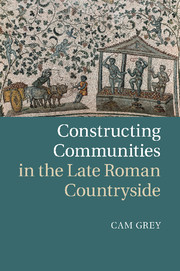Book contents
- Frontmatter
- Contents
- Preface
- List of abbreviations
- Map The late Roman world (sites and regions discussed in the text)
- Introduction
- Chapter 1 Constituting communities
- Chapter 2 What really matters
- Chapter 3 Small politics
- Chapter 4 Power as a competitive exercise
- Chapter 5 Resistance, negotiation, and indifference
- Chapter 6 Creating communities
- Chapter 7 Unintended consequences
- Conclusions
- Bibliography
- Index
Conclusions
Published online by Cambridge University Press: 07 September 2011
- Frontmatter
- Contents
- Preface
- List of abbreviations
- Map The late Roman world (sites and regions discussed in the text)
- Introduction
- Chapter 1 Constituting communities
- Chapter 2 What really matters
- Chapter 3 Small politics
- Chapter 4 Power as a competitive exercise
- Chapter 5 Resistance, negotiation, and indifference
- Chapter 6 Creating communities
- Chapter 7 Unintended consequences
- Conclusions
- Bibliography
- Index
Summary
The countrysides of the late Roman world contained a multiplicity of communities, each characterized by highly complex, interwoven systems of socio-economic interaction. Those systems involved relationships of reciprocity and mutual support that were transacted vertically with individuals of greater power, wealth, and status, and horizontally with individuals whose socio-economic circumstances were broadly commensurate. The character of a particular community emerged from the combination of horizontal and vertical alliances in specific circumstances, but it is clear that the social dynamics of rural communities in the late Roman world revolved first and foremost around maintaining a balance between the cohesion of the group and the conflicting desires and objectives of the individuals, families, and households of which it was composed.
This book has focused upon that tension, and used it as a tool for explicating the various social matrices that constituted the rural communities of the period. In particular, it has placed the twin phenomena of subsistence and social risk at the center of its analysis. The two are intimately linked: the management of subsistence risk is the principal objective of any peasant household, and characteristically entails among other things involvement in a collection of interactions and relations with other households. Those interactions expand the household’s pool of contacts for managing subsistence crisis, but they also increase the likelihood of conflict and disagreement between households. That conflict and disagreement is characteristically managed, negotiated, and defused using a range of strategies, including the mediation by the community of the behavior of its own members through gossip, exchange of goods, services, and expressions of mutual affection, and carefully staged communal activities, as well as recourse to figures of power and representatives of the state by the group or certain of its members.
- Type
- Chapter
- Information
- Constructing Communities in the Late Roman Countryside , pp. 226 - 229Publisher: Cambridge University PressPrint publication year: 2011

